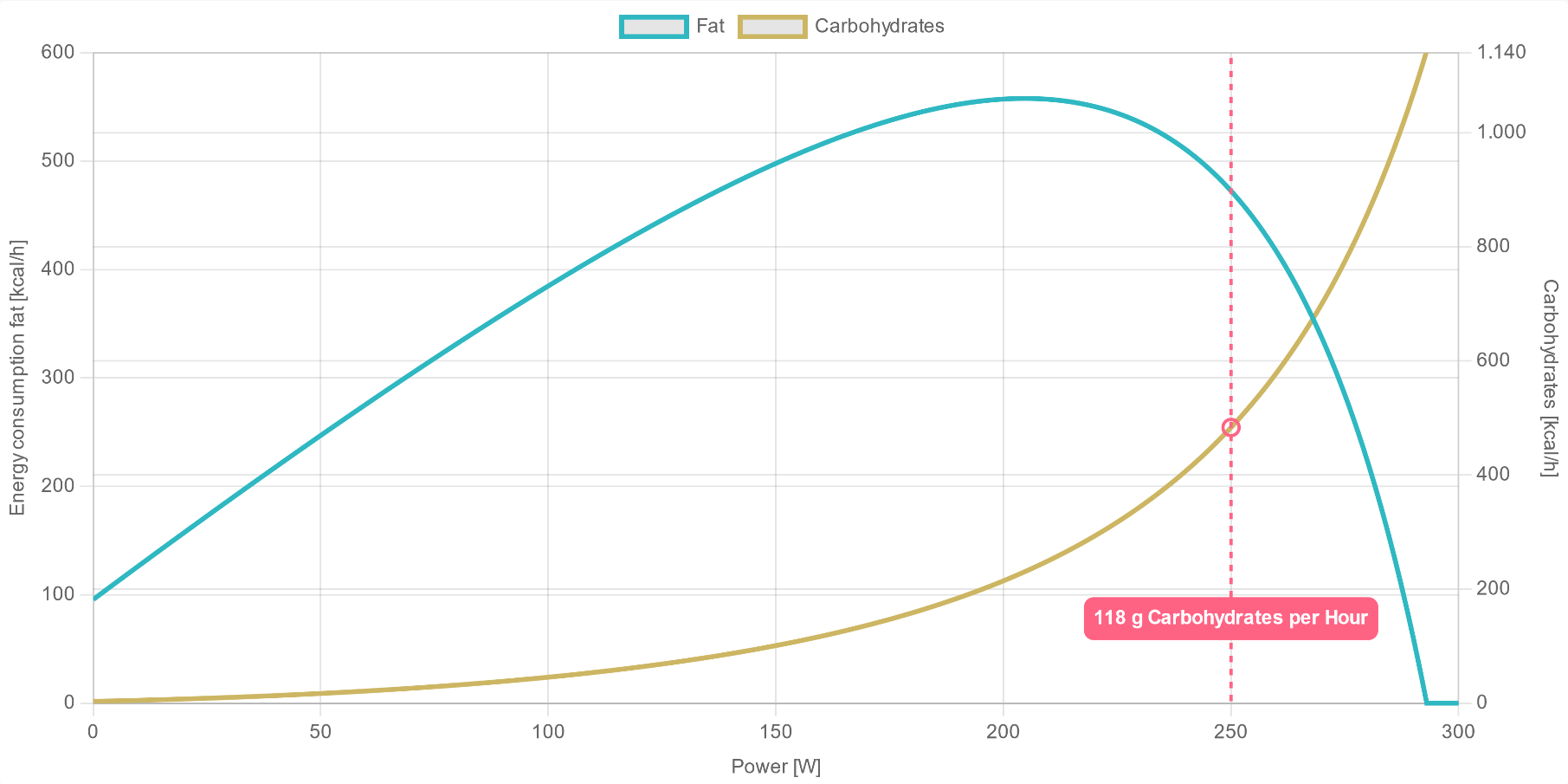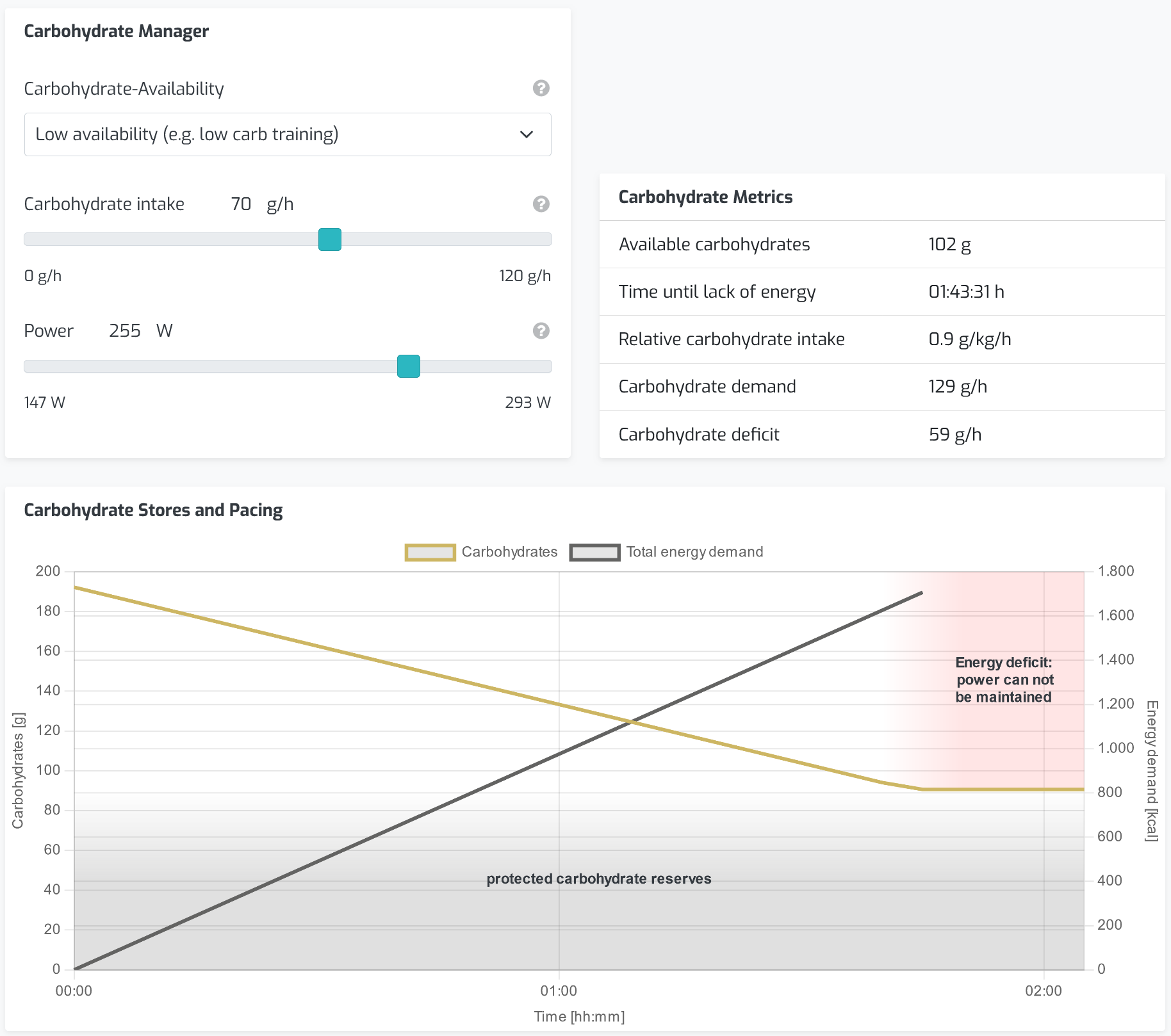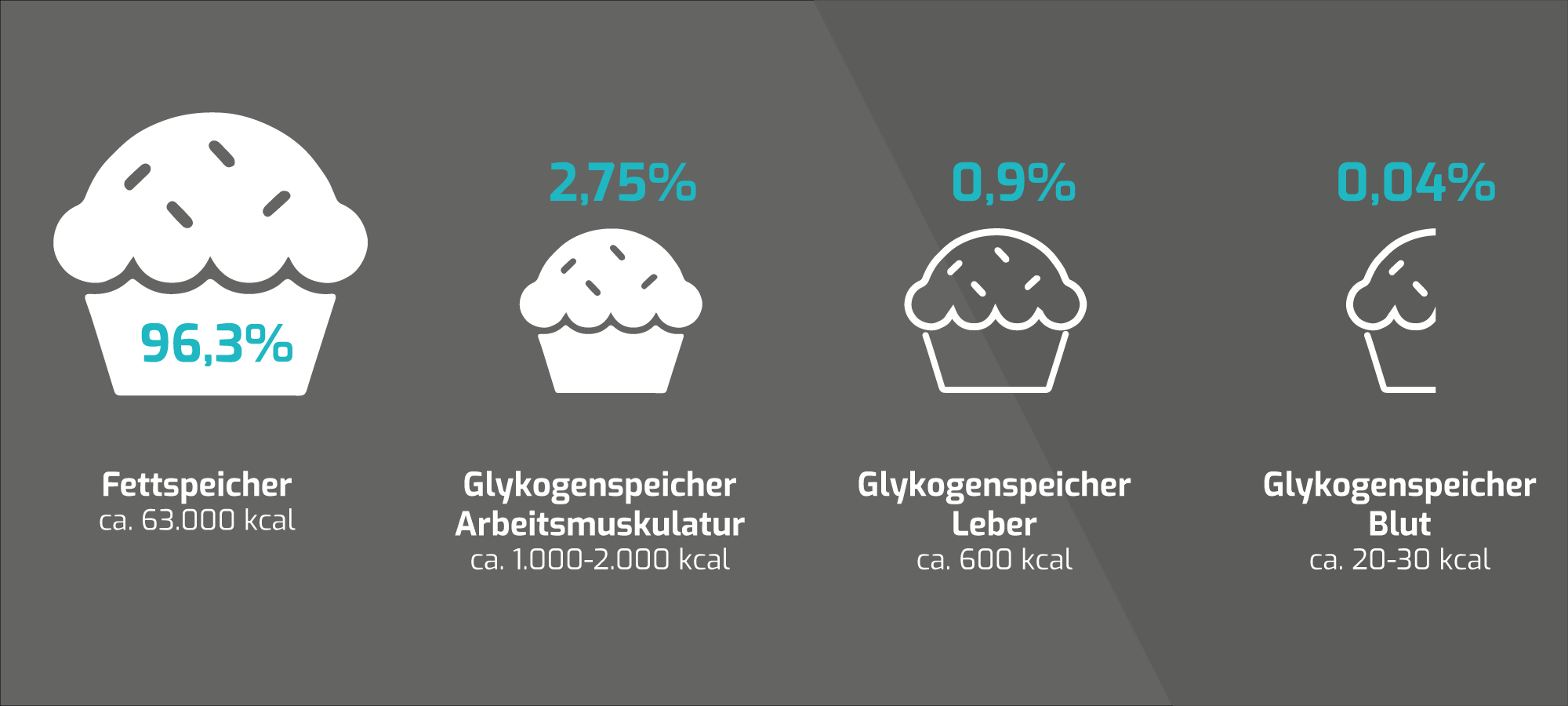Glycogen Stores and Carb Loading
Next to fatty acids, carbohydrates are the most important energy source in endurance sports. The higher the intensity, the more energy is provided by carbohydrates and the more important the amount of glycogen (the storage form of carbohydrates), stored in the muscles and liver, becomes. If no exogenous carbohydrates are consumed (gels or drinks), the glycogen stores will sooner or later be depleted, and performance will decrease. Empty glycogen stores manifest themselves, in the form of "bonking" and cause a significant drop in performance. Thus, carbohydrate and glycogen availability are probably the major limiting factors in prolonged and constant endurance exercise.
What Is Glycogen?
Glycogen is a form of glucose storage in the human body. Glucose is a simple sugar and an essential source of energy for the muscles. After entering the blood, it can be used directly or stored for later use. Glucose is stored in the form of glycogen in the liver and muscle cells so that the body can access it whenever needed.
Glycogen stores in endurance sports: why is it important?
In endurance sports, glycogen stores are crucial to maintain performance. Especially during intense exercise, carbohydrate metabolism (glycolysis) provides most of the energy. When glycogen stores are depleted, an important fuel is missing which results in a rapid performance decrease.
Almost the entire carbohydrate reserves are stored in the form of glycogen in the working muscles (and smaller amounts in the liver). Knowing the size of one's own glycogen stores and individual carbohydrate expenditure is essential to optimize nutrition and pacing strategies in training and competition.
An athlete can absorb between 60 and 120 grams of carbohydrates per hour via solid and liquid food depending on exercise intensity, training status, gender, weight, and digestibility. However, if the expenditure ranges between 150 and 200 grams of carbohydrates per hour, then in the fourth hour of racing the stores are emptied to such an extent that performance drops drastically. When the carbohydrate stores are "empty", the term "bonking" is commonly used in sports.
As shown in the graphic Metabolism / Energy Consumption, carbohydrates are always consumed for energy production. As effort increases, carbohydrate consumption, unlike fat metabolism, rises exponentially. The higher the intensity, the faster the carbohydrate stores are depleted.
The contribution of carbohydrates to energy production depends on training status and the individual physiology. Thus, a high glycolytic energy contribution results in increased carbohydrate consumption even at submaximal intensities. The metric used to assess glycolytic activity is called VLamax (maximum lactate production rate). A low VLamax indicates a lower contribution of carbohydrate metabolism to energy supply. AI DIAGNOSTICS determines fat and carbohydrate consumption during exercise and calculates the available glycogen stores.
In this example, the athlete consumes 118 grams of carbohydrates per hour at 250 watts of continuous power output.

Energy diagram of an exemplary AI DIAGNOSTICS performance report
How Much Glycogen Is Stored in My Body?
The amount of glycogen stored is highly individual and depends on body composition, muscle mass, fitness level, and diet. Glycogen cannot be transported between muscles. The amount of glycogen available in the working muscles (lower body in cycling) is crucial.
Depending on the metabolic profile and glycogen availability, glycogen stores last for 40 to 90 minutes at an intensity around anaerobic threshold. Important to note: Carbohydrate stores are never fully depleted, and 15 to 20 percent of the glycogen stores are retained by the body as autonomic reserves.
Available glycogen amounts to an estimated 400 to 600 grams of muscle glycogen and 80 to 120 grams of liver glycogen. Based on established literature and data collected in the laboratory, the AI DIAGNOSTICS Carbohydrate Manager determines the size of individual glycogen stores.
Calculate Glycogen Stores using the AI DIAGNOSTICS Carbohydrate Manager
The AI DIAGNOSTICS Carbohydrate Manager calculates the size of the available glycogen stores over the time of an athletic effort according to an individual metabolic profile.

Carbohydrate Manager related to an an exemplary AI DIAGNOSTICS performance report
Learn more about the AI DIAGNOSTICS carbohydrate manager.
Glycogen Stores and Carbohydrate Availability in Training and Competition
Glycogen stores can be conserved during training and competition by supplying exogenous carbohydrates, for example through drinks or gels. However, since the intake of carbohydrates is limited to 60 to 120 grams per hour, high consumption of carbohydrates will sooner or later lead to depleted glycogen stores.
Even a well-trained 70-kilogram amateur athlete still has 7 kilograms of fat mass at a body fat percentage of 10 percent. The high energy density of one kilogram of body fat (9 kilocalories per gram) results in a theoretically available energy amount of about 63,000 kilocalories.

Example of a 70-kilogram athlete with 10 percent body fat
Carbohydrate Periodization in Endurance Training
Carbohydrate periodization refers to the selective management of carbohydrate intake before and during training. In this way, carbohydrate availability can be directed during training to increase the training stimulus and improve recovery. In other words, carbohydrate periodization means adjusting nutrition to specific training goals. One example is low-carb training, which is used specifically to train fat metabolism.
Carbohydrate periodization in training can be divided into three categories. Depending on the training goal and intensity, the supply of carbohydrates is adjusted accordingly.
Low Carbohydrate Availability
Low carbohydrate intake has become especially known as low-carb training. Low-carb training is not to be confused with "fasted" training, which should be avoided in most cases. Low-carb means a reduced intake of carbohydrates before training or starting training with pre-emptied glycogen stores. When the body has fewer carbohydrates available, it has to use more fatty acids as energy source and the fat metabolism increases.
Low carbohydrate intake has become especially known as low-carb training. Low-carb training is not to be confused with "fasted" training, which should be avoided in most cases. Low-carb means a reduced intake of carbohydrates before training or starting training with pre-emptied glycogen stores. When the body has fewer carbohydrates available, it has to use more fatty acids as energy source and the fat metabolism increases.
ImportantLow-carb training should not be done more than two to three times per week and should be applied very carefully. As can be seen in the AI DIAGNOSTICS performance report, even at low intensities in the E1 and Fatmax zone, relatively high amounts of carbohydrates are combusted. To avoid "bonking" and a catabolic metabolism during training, 30 to 60 grams of carbohydrates should be supplied even during low-carb training sessions starting at about 90 to 120 minutes into the session.
Medium Carbohydrate Availability
With a medium carbohydrate intake, the carbohydrate availability is neither particularly high nor particularly low. The amount depends on training intensity as well as the nutrition between the training sessions. The idea is "as much as necessary" and maintaining muscle glycogen stores is the goal. For shorter workouts, 20 to 40 grams per hour should be provided, and for longer or more intense sessions, 40 to 60 grams of carbohydrates per hour are recommended.
High Carbohydrate Availability
High carbohydrate availability or high-carb training means a high carbohydrate intake before and during the training session. This means training starts with relatively full glycogen stores and energy intake during training remains high. The goal is to ensure energy supply for high training intensities or to train the carbohydrate absorption of the gastrointestinal tract ("train the gut"). Depending on tolerability and fitness level, amounts in the range of 60 to 120 grams of carbohydrates per hour are recommended.
Carb Loading in Endurance Sports
Carb loading is the intentional replenishment of glycogen stores 24 to 48 hours before a competition.
In everyday training, the carbohydrate stores are emptied and replenished on a daily basis, and the ambitious endurance athlete, therefore, engages in a form of carb loading every day. Before a major competition, it is important to replenish the glycogen stores in order to start with maximum energy reserves. In competitions lasting 90 minutes or longer, glycogen availability is absolutely limiting for performance. The last 1 to 2 days before the event are sufficient to maximally replenish glycogen stores and the frequently mentioned depletion phase and low-carb diets prior to carb loading are not beneficial.
The better the fitness level, the more glycogen can be stored. This is the reason why the glycogen stores of amateur and professional athletes vary even with identical body compositions. Due to the constant emptying and replenishing in everyday training, well-trained athletes can replenish their muscle glycogen stores faster than the untrained.
The well-trained endurance athlete also has a better fat metabolism, so that fewer carbohydrates are consumed and the glycogen stores are maintained for longer. With AI DIAGNOSTICS you can determine both your carbohydrate consumption and the size of your glycogen stores and optimize the nutrition strategy for training and competition.
It is recommended to consume 8 to 12 grams of carbohydrates per kilogram the day before a competition. An athlete weighing 70 kilograms should therefore consume around 700 grams of carbohydrates throughout the day. For each gram of glycogen, about 3 grams of water are bound and stored in the muscles. This means that with full glycogen stores, the additional water storage also leads to a weight gain of up to 1.5 kilograms.
The situation becomes more complicated on successive race days such as the Tour de France, where glycogen stores are depleted daily and must be replenished within a short period of time.
Tips for Carb Loading before Competition:
- One to two days before the competition are all you need to maximally replenish glycogen stores.
- Recommended are 8 to 12 grams of carbohydrates per kilogram of body weight within the 24 hours prior.
- The carbohydrates consumed during the activation session the day before must be added to the overall amount. A carbohydrate deficit during training sessions two days before a race should be avoided.
- It makes sense to provide a higher amount of carbohydrates during the activation and training sessions before the competition, as the absorption rate of carbohydrates is increased under moderate intensity.
- Fatty foods and those containing fiber should be avoided the day before.
- Carbohydrates intake should be accompanied by fluid intake.
- Carbohydrates should be supplied through many small meals throughout the day.
- Easily digestible carbohydrates in the form of pasta, rice (with honey), and potatoes are recommended. If you have problems with the intake of carbohydrates, you can also use fruit juices and sweets.
- The breakfast in the morning before a race serves to replenish the liver glycogen - which was reduced overnight (approx. 80 to 120g). For example, white bread with jam or porridge with water and honey is recommended.
Replenishing Glycogen Stores after Training and Competition
For optimal recovery after an intense workout or competition, it is important to replenish glycogen stores as soon as possible (glycogen synthesis). The highest rate of glycogen synthesis is achieved when approximately 1 to 1.2 grams of carbohydrate per kilogram of body weight per hour (g/kg/h) are consumed within 15 to 30 minutes after exercise. Immediately after exercise, the rate of intake is highest and remains elevated for 4 to 5 hours after exercise. If insufficient carbohydrates are supplied during this time, the resynthesis of glycogen stores will drop by up to 50 percent. Alternatively, if less than 1.2 g/kg/h is consumed during this time, the rate of synthesis can be increased by supplying additional protein (approximately 0.4 g/kg/h).
Tips for Replenishing Glycogen Stores after Training and Competition:
- Immediately after exercise, carbohydrates should be ingested at approximately 1 to 1.2 g/kg/h within 30 minutes. Depending on the duration and intensity of exercise, intake should be maintained for up to 4 hours after exercise.
- It is recommended to add a recovery shake with 0.8 to 1 g/kg carbohydrates and 0.3 to 0.4 g/kg proteins directly after training to optimize muscle protein synthesis and glycogen synthesis.
- Glycogen intake remains elevated for up to 5 hours after the end of exercise.
- Carbohydrate intake should be accompanied by fluid intake. Depending on hydration status with approximately 0.8 to 1.5 liters of fluid.
- Glycogen synthesis can be supported by active recovery methods
Training to Reduce Carbohydrate Consumption
Higher intensities in endurance sports require a lot of energy, and the less trained the fat metabolism the more energy is derived from carbohydrates. Therefore, in order to conserve glycogen stores, fat metabolism should be trained.
Here you will learn how to train your fat metabolism and lower the VLamax.